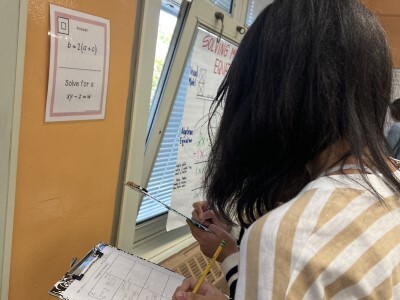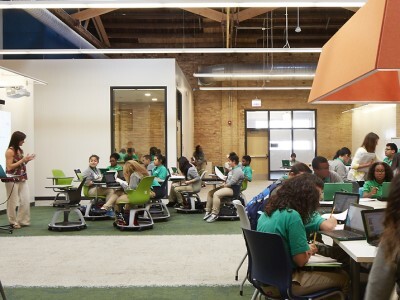Defining Personalization: Students As Agents and Teachers As Coaches
Topics
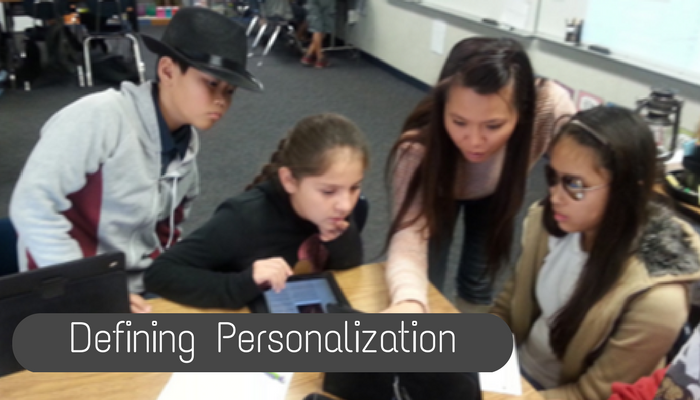
We’ve all had the experience of truly purposeful, authentic learning and know how valuable it is. Educators are taking the best of what we know about learning, student support, effective instruction, and interpersonal skill-building to completely reimagine schools so that students experience that kind of purposeful learning all day, every day.
Three school examples show that personalization is most effective when students become active agents involved in determining what and how they learn.
This post originally appeared on Next Gen Learning in Action on Education Week.
We all know what powerful learning feels like. It's immersive and relevant. You know and feel that you are mastering something important. In a word, it's profoundly personal. When educators know students well and design richly built-out learning experiences that are tailored to what works best for each of them, they are practicing personalized learning.
To many, personalization may feel like the latest in a long series of educational fads. But in fact, it has its roots in an honored, tried-and-true strategy: differentiation. And while it helps to contextualize personalization through association to differentiation, there are some key differences between the two.
Differentiation starts with academic goals that are the same for the group. Personalization builds on these common standards but also considers the personal learning goals that are especially meaningful to each student. Furthermore, personalization not only shifts classroom instruction, it also shifts the role of students and teachers.
There is a good deal of debate about what personalized learning is, and what merits it has as a learning model—so it warrants taking a second here to stop and level-set. In our view, personalization is most effective in learning environments when students become active agents involved in determining what they learn (content), how and how fast they learn (process and pace), and/or how they demonstrate their learning (work products). In this personalized learning approach, teachers become group facilitators, personal coaches, and support specialists as children engage in authentic and deep learning experiences connected to both a set of standards and their own life goals.
Personalized learning is just one expression of next gen learning—which involves rich learning experiences focused on a broad and integrated set of competencies that students need to thrive in today's world. This blog will continue to explore other models and expressions of next gen learning. For this post, though, we are focused on the ways that personalization changes the learning experience for students and the role of teachers in classrooms.
What does personalization look like in practice?
The thing about personalization that often gets lost in the larger conversation about the value of personalized learning is that there isn't one model; rather, the models that work are as unique to the school communities as they are to the students in those classrooms. Below are a few examples of schools that have embraced personalized learning, to give greater context to how a school embracing personalization could be organized and how learning happens.
Piedmont City School District, Piedmont, AL
Set within a small rural community, this district has spent the last several years transitioning to a mastery-based, personalized learning model, starting with the middle school and now extending up into the high school and down into the elementary school. A high-performing school, the percentage of students at Piedmont Middle School who score "Advanced" on assessments consistently exceeds the state average. But the district recognized, through participation in a Gallup Student Poll, that students' hope for their future, engagement, and well-being were low. They created a new learning design, "mBolden Piedmont," with three main goals: advanced mastery, relevance, and student ownership. This learning model builds on the district's existing assets, including prior investments in infrastructure, devices, and digital content.
Personalized learning for Piedmont's students—who may feel isolated with limited access to career and learning opportunities in the immediate area—means exposing students to a broad range of career options, introducing them to global mentors, creating learning opportunities relevant to their personal life goals, and helping them connect their daily learning to a future they can imagine and create for themselves. Students engage in autonomous learning through a self-directed learning block called "My Time." They demonstrate advanced mastery of the state's standards through hands-on projects, original creations, and experiments. Teachers also collaborate with students on setting academic goals and exploring careers as a part of a regularly scheduled block called "Team Time." These ongoing goal setting and career exploration activities guide the self-directed learning.
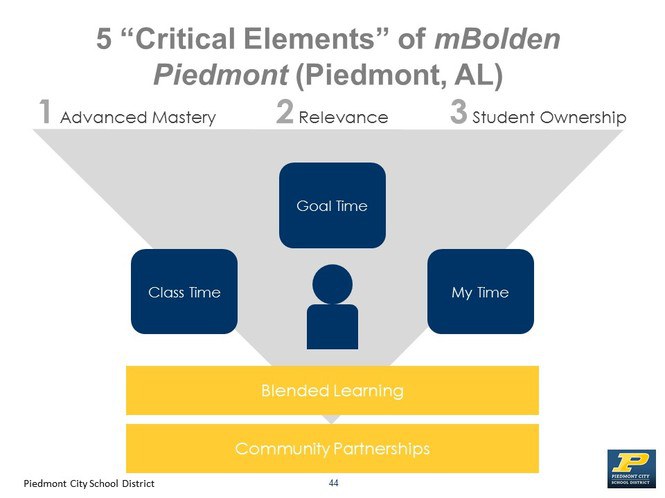
mBolden Model. Piedmont City School District.
Teachers are shifting their practice with strategies such as using data on a daily basis to regroup students, select content, and determine the next instructional steps for each student. They are grappling with new questions like, what is the right depth on standards required for mastery? Do we need to incorporate more project-based learning to make sure this depth of learning is reached? Which learning experiences will help a particular student make progress to master a standard?
Fullerton School District, Fullerton, CA
This district is using a quest-based augmented reality game, developed in-house, to personalize learning and increase student engagement. In the game, called iPersonalize, students follow an "epic storyline," an individualized learning pathway that includes whole group, small group, and one-on-one instruction with both digital and physical content and activities. Students move at their own pace toward the standards and their progress is tracked using leaderboards and badges. They monitor their own progress through the Met, Not Yet, and Mastered awards they earn during lesson cycles. They earn experience points and "level up" when they can demonstrate mastery of a learning goal. If a student doesn't meet proficiency, teachers provide a Response to Intervention Tier I intervention as soon as a student demonstrates a need: they can "respawn" and continue to engage with the content through guided practice. The approach prevents students from needing more drastic interventions down the road.
Overall, students are mastering content standards at a faster pace because they are so deeply engaged in the learning.

Not Yet, Met, and Mastered Awards. Fullerton School District.
Teacher involvement has been voluntary. It started in the summer of 2014 with a pilot group of 14 teachers. In the current year, over 50 teachers across the district volunteered. With professional development and support that included a week-long summer immersion in iPersonalize, teachers worked together to develop the game's quests and the projects. The content has been validated by Marzano Labs for quality, rigor, and alignment to standards. Teachers do not see themselves as "sage on the stage" nor "guide on the side." As one teacher described their role, "An FSD iPersonalize educator is a 'guide on the ride.'"
Summit Public Schools, Bay Area, CA
This charter network prepares students for college, career, and life through self-directed, supported learning of cognitive skills, content knowledge, habits of success, and real-life experiences. With the assistance of their teachers, every student creates a personalized learning plan that is aligned to their personal life goals. The daily schedule calls for students to take more active roles in their learning with time for interdisciplinary project-based learning, individual self-directed learning for developing content knowledge, sustained reading and math problem-solving, and working with a peer group and teacher-mentor. The academic year is broken up by four two-week expedition sessions where students engage in elective, real-world, passion-based experiences. A cornerstone of the Summit personalized learning model is the Summit Learning Platform.
Teachers work with students to help them develop the skills of self-directed learning: challenge-seeking, persistence, strategy-shifting, response to setback, and help-seeking. A teacher-mentor works with each student to set goals and develop a personalized learning plan. Teachers design projects and identify content, facilitate one-on-one and small-group learning opportunities, and provide customized academic support.
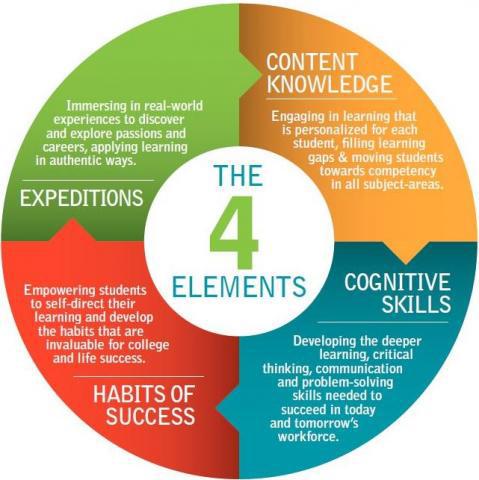
Four Elements of College Readiness. Summit Public Schools.
Summit Public Schools is partnering with over 100 public schools that are adopting personalized learning through its free Summit Learning Program. Participating schools engage in a learning community to design and plan together as they implement personalized learning in their classrooms. The Summit Learning Program includes in-person professional development, ongoing support, and access to the Summit Learning Platform. The platform includes a complete project-based curriculum, personalized playlists, assessments, and other components of Summit's approach to personalized learning.
In our next post, we'll take a look at what these schools have in common, such as experiential learning and strong teacher-student relationships. We'll also identify some challenges of personalized learning in practice and explore the role of technology as an enabler of learning rather than a required tool.



